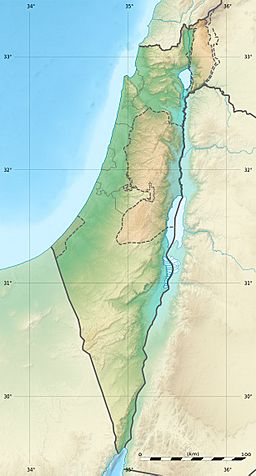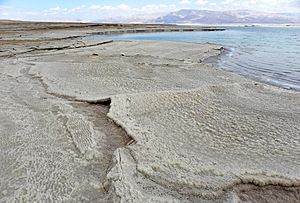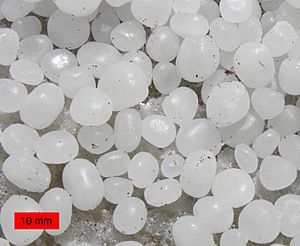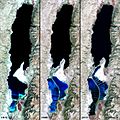Dead Sea facts for kids
Quick facts for kids Dead Sea |
|
|---|---|

A view of the sea from the Israeli shore
|
|
| Location | Western Asia |
| Coordinates | 31°30′N 35°30′E / 31.500°N 35.500°E |
| Lake type | Endorheic Hypersaline |
| Native name | |
| Primary inflows | Jordan River |
| Primary outflows | None |
| Catchment area | 41,650 km2 (16,080 sq mi) |
| Basin countries | Israel, Jordan, and the West Bank |
| Max. length | 50 km (31 mi) (northern basin only) |
| Max. width | 15 km (9.3 mi) |
| Surface area | 605 km2 (234 sq mi) (2016) |
| Average depth | 199 m (653 ft) |
| Max. depth | 298 m (978 ft) (elevation of deepest point, 728 m BSL [below sea level], minus current surface elevation) |
| Water volume | 114 km3 (27 cu mi) |
| Shore length1 | 135 km (84 mi) |
| Surface elevation | −430.5 m (−1,412 ft) (2016) |
| 1 Shore length is not a well-defined measure. | |
The Dead Sea is a lake between the West Bank and Jordan. It is 418 metres (1,371 feet) below sea level. It is the lowest point on the surface of the Earth.
The Dead Sea is almost nine times as salty as the ocean. That makes it impossible for most life to exist in it. This is the reason for its name. However, it is not completely dead, because some types of bacteria are able to live in the water.
Because the water is so salty, it weighs more than fresh water. That lets people float in the Dead Sea without any effort. Tourists come from around the world to float in the water.
Contents
Geography
The Dead Sea is an endorheic lake located in the Jordan Rift Valley, a geographic feature formed by the Dead Sea Transform (DST). This left lateral-moving transform fault lies along the tectonic plate boundary between the African Plate and the Arabian Plate. It runs between the East Anatolian Fault zone in Turkey and the northern end of the Red Sea Rift offshore of the southern tip of Sinai.
The Jordan River is the only major water source flowing into the Dead Sea, although there are small perennial springs under and around the Dead Sea, forming pools and quicksand pits along the edges. There are no outlet streams.
Rainfall is scarcely 100 mm (4 in) per year in the northern part of the Dead Sea and barely 50 mm (2 in) in the southern part. The Dead Sea zone's aridity is due to the rainshadow effect of the Judean Hills. The highlands east of the Dead Sea receive more rainfall than the Dead Sea itself.
To the west of the Dead Sea, the Judean Hills rise less steeply and are much lower than the mountains to the east. Along the southwestern side of the lake is a 210 m (700 ft) tall halite formation called "Mount Sodom".
Natural history
There are two contending hypotheses about the origin of the low elevation of the Dead Sea. The older hypothesis is that it lies in a true rift zone, an extension of the Red Sea Rift, or even of the Great Rift Valley of eastern Africa. A more recent hypothesis is that the Dead Sea basin is a consequence of a "step-over" discontinuity along the Dead Sea Transform, creating an extension of the crust with consequent subsidence.
Around three million years ago, what is now the valley of the Jordan River, Dead Sea, and Wadi Arabah was repeatedly inundated by waters from the Mediterranean Sea. The waters formed in a narrow, crooked bay which was connected to the sea through what is now the Jezreel Valley. The floods of the valley came and went depending on long scale climate change. The lake that occupied the Dead Sea Rift, named Lake Sedom, deposited beds of salt that eventually became 3 km (2 mi) thick.
Approximately two million years ago, the land between the Rift Valley and the Mediterranean Sea rose to such an extent that the ocean could no longer flood the area. Thus, the long bay became a lake.
The first such prehistoric lake is named "Lake Amora", which was a freshwater or brackish lake that extended at least 80 km (50 mi) south of the current southern end of the Dead Sea and 100 km (60 mi) north, well above the present Hula Depression. As the climate became more arid, Lake Amora shrank and became saltier. The large, saltwater predecessor of the Dead Sea is called "Lake Lisan".
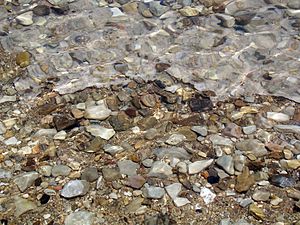
In prehistoric times, great amounts of sediment collected on the floor of Lake Amora. The sediment was heavier than the salt deposits and squeezed the salt deposits upwards into what are now the Lisan Peninsula and Mount Sodom (on the southwest side of the lake). Geologists explain the effect in terms of a bucket of mud into which a large flat stone is placed, forcing the mud to creep up the sides of the pail. When the floor of the Dead Sea dropped further due to tectonic forces, the salt mounts of Lisan and Mount Sodom stayed in place as high cliffs (see salt dome).
From 70,000 to 12,000 years ago, the lake level was 100 m (330 ft) to 250 m (820 ft) higher than its current level. This lake, called "Lake Lisan", fluctuated dramatically, rising to its highest level around 26,000 years ago, indicating a very wet climate in the Near East. Around 10,000 years ago, the lake level dropped dramatically, probably to levels even lower than today. During the last several thousand years, the lake has fluctuated approximately 400 m (1,300 ft), with some significant drops and rises. Current theories as to the cause of this dramatic drop in levels rule out volcanic activity; therefore, it may have been a seismic event.
Climate
The Dead Sea's climate offers year-round sunny skies and dry air. It has less than 50 millimetres (2 in) mean annual rainfall and a summer average temperature between 32 and 39 °C (90 and 102 °F). Winter average temperatures range between 20 and 23 °C (68 and 73 °F). The region has weakened ultraviolet radiation, particularly the UVB (erythrogenic rays), and an atmosphere characterized by a high oxygen content due to the high barometric pressure. The sea affects temperatures nearby because of the moderating effect a large body of water has on climate. During the winter, sea temperatures tend to be higher than land temperatures, and vice versa during the summer months. This is the result of the water's mass and specific heat capacity. On average, there are 192 days above 30C (86F) annually.
| Climate data for Dead Sea | |||||||||||||
|---|---|---|---|---|---|---|---|---|---|---|---|---|---|
| Month | Jan | Feb | Mar | Apr | May | Jun | Jul | Aug | Sep | Oct | Nov | Dec | Year |
| Record high °C (°F) | 26.4 (79.5) |
30.4 (86.7) |
33.8 (92.8) |
42.5 (108.5) |
45.0 (113.0) |
46.4 (115.5) |
47.0 (116.6) |
44.5 (112.1) |
43.6 (110.5) |
40.0 (104.0) |
35.0 (95.0) |
28.5 (83.3) |
47.0 (116.6) |
| Mean daily maximum °C (°F) | 20.5 (68.9) |
21.7 (71.1) |
24.8 (76.6) |
29.9 (85.8) |
34.1 (93.4) |
37.6 (99.7) |
39.7 (103.5) |
39.0 (102.2) |
36.5 (97.7) |
32.4 (90.3) |
26.9 (80.4) |
21.7 (71.1) |
30.4 (86.7) |
| Mean daily minimum °C (°F) | 12.7 (54.9) |
13.7 (56.7) |
16.7 (62.1) |
20.9 (69.6) |
24.7 (76.5) |
27.6 (81.7) |
29.6 (85.3) |
29.9 (85.8) |
28.3 (82.9) |
24.7 (76.5) |
19.3 (66.7) |
14.1 (57.4) |
21.9 (71.4) |
| Record low °C (°F) | 5.4 (41.7) |
6.0 (42.8) |
8.0 (46.4) |
11.5 (52.7) |
19.0 (66.2) |
23.0 (73.4) |
26.0 (78.8) |
26.8 (80.2) |
24.2 (75.6) |
17.0 (62.6) |
9.8 (49.6) |
6.0 (42.8) |
5.4 (41.7) |
| Average precipitation mm (inches) | 7.8 (0.31) |
9.0 (0.35) |
7.6 (0.30) |
4.3 (0.17) |
0.2 (0.01) |
0.0 (0.0) |
0.0 (0.0) |
0.0 (0.0) |
0.0 (0.0) |
1.2 (0.05) |
3.5 (0.14) |
8.3 (0.33) |
41.9 (1.65) |
| Average precipitation days | 3.3 | 3.5 | 2.5 | 1.3 | 0.2 | 0.0 | 0.0 | 0.0 | 0.0 | 0.4 | 1.6 | 2.8 | 15.6 |
| Average relative humidity (%) | 41 | 38 | 33 | 27 | 24 | 23 | 24 | 27 | 31 | 33 | 36 | 41 | 32 |
| Source: Israel Meteorological Service | |||||||||||||
Chemistry
Until the winter of 1978–79, when a major mixing event took place, the Dead Sea was composed of two stratified layers of water that differed in temperature, density, age, and salinity. The topmost 35 meters (115 ft) or so of the Dead Sea had a salinity that ranged between 300 and 400 parts per thousand and a temperature that swung between 19 °C (66 °F) and 37 °C (99 °F). Underneath a zone of transition, the lowest level of the Dead Sea had waters of a consistent 22 °C (72 °F) temperature and complete saturation of sodium chloride (NaCl). Since the water near the bottom is saturated, the salt precipitates out of solution onto the sea floor.
Beginning in the 1960s, water inflow to the Dead Sea from the Jordan River was reduced as a result of large-scale irrigation and generally low rainfall. By 1975, the upper water layer was saltier than the lower layer. Nevertheless, the upper layer remained suspended above the lower layer because its waters were warmer and thus less dense. When the upper layer cooled so its density was greater than the lower layer, the waters mixed (1978–79). For the first time in centuries, the lake was a homogeneous body of water. Since then, stratification has begun to redevelop.
The mineral content of the Dead Sea is very different from that of ocean water. The exact composition of the Dead Sea water varies mainly with season, depth and temperature. In the early 1980s, the concentration of ionic species (in g/kg) of Dead Sea surface water was Cl− (181.4), Br− (4.2), SO42− (0.4), HCO3− (0.2), Ca2+ (14.1), Na+ (32.5), K+ (6.2) and Mg2+ (35.2). The total salinity was 276 g/kg. These results show that the composition of the salt, as anhydrous chlorides on a weight percentage basis, was calcium chloride (CaCl2) 14.4%, potassium chloride (KCl) 4.4%, magnesium chloride (MgCl2) 50.8% and sodium chloride (common salt, NaCl) 30.4%. In comparison, the salt in the water of most oceans and seas is approximately 97% sodium chloride. The concentration of sulfate ions (SO42−) is very low, and the concentration of bromide ions (Br−) is the highest of all waters on Earth.
The salt concentration of the Dead Sea fluctuates around 31.5%. This is unusually high and results in a nominal density of 1.24 kg/l. Anyone can easily float in the Dead Sea because of natural buoyancy. In this respect the Dead Sea is similar to the Great Salt Lake in Utah in the United States.
An unusual feature of the Dead Sea is its discharge of asphalt. From deep seeps, the Dead Sea constantly spits up small pebbles and blocks of the black substance. Asphalt coated figurines and bitumen coated Neolithic skulls from archaeological sites have been found. Egyptian mummification processes used asphalt imported from the Dead Sea region.
Health effects and therapies
The Dead Sea area has become a major center for health research and treatment for several reasons. The mineral content of the water, the very low content of pollens and other allergens in the atmosphere, the reduced ultraviolet component of solar radiation, and the higher atmospheric pressure at this great depth each have specific health effects. For example, persons experiencing reduced respiratory function from diseases such as cystic fibrosis seem to benefit from the increased atmospheric pressure.
The region's climate and low elevation have made it a popular center for several types of therapies:
- Climatotherapy: Treatment which exploits local climatic features such as temperature, humidity, sunshine, barometric pressure and special atmospheric constituents
- Heliotherapy: Treatment that exploits the biological effects of the sun's radiation
- Thalassotherapy: Treatment that exploits bathing in Dead Sea water
Treatment for psoriasis
Climatotherapy at the Dead Sea is an effective therapy for patients with psoriasis, who benefit from sunbathing for long periods in the area due to its position below sea level and subsequent result that many of the sun's harmful UV rays are reduced.
Treatment for rhinosinusitis
Rhinosinusitis patients receiving Dead Sea saline nasal irrigation exhibited significantly better symptom relief compared to standard hypertonic saline spray.
Treatment for osteoarthritis
Dead Sea mud pack therapy has been suggested to temporarily relieve pain in patients with osteoarthritis of the knees. According to researchers of the Ben Gurion University of the Negev, treatment with mineral-rich mud compresses can be used to augment conventional medical therapy.
Fauna and flora
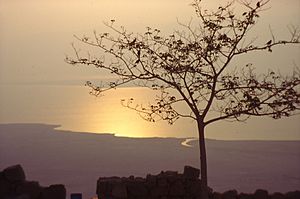
The sea is called "dead" because its high salinity prevents macroscopic aquatic organisms, such as fish and aquatic plants, from living in it, though minuscule quantities of bacteria and microbial fungi are present.
In times of flood, the salt content of the Dead Sea can drop from its usual 35 to 30% or lower. The Dead Sea temporarily comes to life in the wake of rainy winters. In 1980, after one such rainy winter, the normally dark blue Dead Sea turned red. Researchers from Hebrew University of Jerusalem found the Dead Sea to be teeming with a type of algae called Dunaliella. The Dunaliella in turn nourished carotenoid-containing (red-pigmented) halobacteria, whose presence caused the color change. Since 1980, the Dead Sea basin has been dry and the algae and the bacteria have not returned in measurable numbers.
Many animal species live in the mountains surrounding the Dead Sea. Hikers can see camels, ibex, hares, hyraxes, jackals, foxes, and even leopards. Hundreds of bird species inhabit the zone as well. Both Jordan and Israel have established nature reserves around the Dead Sea.
The delta of the Jordan River was formerly a jungle of papyrus and palm trees. The Jewish historian Flavius Josephus described Jericho as "the most fertile spot in Judea". In Roman and Byzantine times, sugarcane, henna, and sycamore fig all made the lower Jordan valley wealthy. One of the most valuable products produced by Jericho was the sap of the balsam tree, which could be made into perfume. By the 19th century, Jericho's fertility had disappeared.
Human settlement
There are several small communities near the Dead Sea. These include Ein Gedi, Neve Zohar and the Israeli settlements in the Megilot Regional Council: Kalya, Mitzpe Shalem and Avnat. There is a nature preserve at Ein Gedi, and several Dead Sea hotels are located on the southwest end at Ein Bokek near Neve Zohar. Highway 90 runs north-south on the Israeli side for a total distance of 565 km from Metula on the Lebanese border in the north to its southern terminus at the Egyptian border near the Red Sea port of Eilat.
Potash City is a small community on the Jordanian side of the Dead Sea. Highway 65 runs north-south on the Jordanian side.
Hebrew Bible
Just north of the Dead Sea is Jericho. Somewhere, perhaps on the southeastern shore, would be the cities mentioned in the Book of Genesis which were said to have been destroyed in the time of Abraham: Sodom and Gomorra (Genesis 18) and the three other "Cities of the Plain", Admah, Zeboim and Zoar (Deuteronomy 29:23). Zoar escaped destruction when Abraham's nephew Lot escaped to Zoar from Sodom (Genesis 19:21-22). Before the destruction, the Dead Sea was a valley full of natural tar pits, which was called the vale of Siddim. King David was said to have hidden from Saul at Ein Gedi nearby.
In Ezekiel 47:8-9 there is a specific prophecy that the sea will ".. be healed and made fresh", becoming a normal lake capable of supporting marine life. A similar prophecy is stated in Zechariah 14:8, which says that "Living waters will go out from Jerusalem, half of them to the eastern sea (likely the Dead Sea) and half to the western sea (the Mediterranean)..."
Josephus identifies the Dead Sea in geographic proximity to the ancient Biblical city of Sodom. However, he refers to the lake by its Greek name, Asphaltites.
History
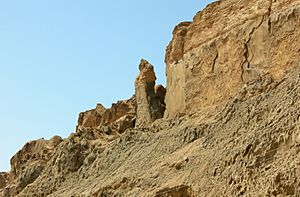
Second Temple period
Dwelling in caves near the Dead Sea is recorded in the Hebrew Bible as having taken place before the Israelites came to Canaan, and extensively at the time of King David. Various sects of Jews settled in caves overlooking the Dead Sea. The best known of these are the Essenes of Qumran, who left an extensive library known as the Dead Sea Scrolls. The town of Ein Gedi, mentioned many times in the Mishna, produced persimmon for the temple's fragrance and for export, using a secret recipe. The "salt of Sodom" was an essential mineral for the temple's holy incense, but was said to be dangerous for home use and could cause blindness. The Roman camps surrounding Masada were built by Jewish slaves receiving water from the towns around the lake. These towns had drinking water from the Ein Feshcha springs and other sweetwater springs in the vicinity.
Ancient times
Aristotle wrote about the remarkable waters. The Nabateans and others discovered the value of the globs of natural asphalt that constantly floated to the surface where they could be harvested with nets. The Egyptians were steady customers, as they used asphalt in the embalming process that created mummies. The Ancient Romans knew the Dead Sea as "Palus Asphaltites" (Asphalt Lake).
Herodian period
King Herod the Great built or rebuilt several fortresses and palaces on the western bank of the Dead Sea. The most famous was Masada, where, in 70–73 CE, a small group of Jewish zealots held out against the might of the Roman legion, and Machaerus where, according to Josephus, John the Baptist was imprisoned by Herod Antipas and died.
Also in Roman times, some Essenes settled on the Dead Sea's western shore; Pliny the Elder identifies their location with the words, "on the west side of the Dead Sea, away from the coast ... [above] the town of Engeda" (Natural History, Bk 5.73); and it is therefore a hugely popular but contested hypothesis today, that same Essenes are identical with the settlers at Qumran and that "the Dead Sea Scrolls" discovered during the 20th century in the nearby caves had been their own library.
In the Bible, the Dead Sea is called the Salt Sea, the Sea of the Arabah, and the Eastern Sea. The designation "Dead Sea" is a modern name which never appears in the Bible. The Dead Sea basin is another part of the Great Rift Valley. It is here that the Upper Jordan River/Sea of Galilee/Lower Jordan River water system comes to an end. Intimately connected with the Judean wilderness to its northwest and west, the Dead Sea was a place of escape and refuge. The remoteness of the region attracted Greek Orthodox monks since the Byzantine era. Their monasteries, such as Saint George in Wadi Kelt and Mar Saba in the Judaean Desert, are places of pilgrimage.
Modern times
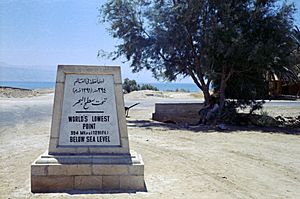
Explorers and scientists arrived in the area to analyze the minerals and research the unique climate. In the late 1940s and early 1950s, hundreds of religious documents dated between 150 BCE and 70 CE were found in caves near the ancient settlement of Qumran, about a mile inland from the northwestern shore of the Dead Sea (presently in the West Bank). They became known and famous as the Dead Sea Scrolls. A golf course named for Sodom and Gomorrah was built by the British at Kalia on the northern shore.
The world's lowest road, Highway 90, runs along the Israeli and West Bank shores of the Dead Sea at 393 m (1,289 ft) below sea level.
The first major hotels were built in nearby Arad, and since the 1960s at the Neve Zohar resort complex. On Jordanian side, three international franchises have opened seaside resort hotels near the King Hussein Bin Talal Convention Center along the eastern coast of the Dead Sea.
Industry
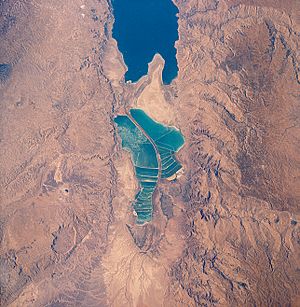

In the early part of the 20th century, the Dead Sea began to attract interest from chemists who deduced the sea was a natural deposit of potash (potassium chloride) and bromine. The Palestine Potash Company was chartered in 1929, after its founder, Siberian Jewish engineer and pioneer of Lake Baikal exploitation, Moses Novomeysky, worked for the charter for over ten years. The first plant was on the north shore of the Dead Sea at Kalya and produced potash by solar evaporation of the brine. Employing Arabs and Jews, it was an island of peace in turbulent times. The company quickly grew into the largest industrial site in the Middle East, and in 1934 built a second plant on the southwest shore, in the Mount Sodom area, south of the 'Lashon' region of the Dead Sea. Palestine Potash Company supplied half of Britain's potash during World War II, but ultimately became a casualty of the 1948 Arab–Israeli War. Its remnants were nationalised and Dead Sea Works Ltd. was established in 1952 in its stead as a state-owned company to extract potash and other minerals from the Dead Sea.
From the Dead Sea brine, Israel produces (2001) 1.77 million tons potash, 206,000 tons elemental bromine, 44,900 tons caustic soda, 25,000 tons magnesium metal, and sodium chloride. On the Jordanian side of the Dead Sea, Arab Potash (APC), formed in 1956, produces 2.0 million tons of potash annually, as well as sodium chloride and bromine. Both companies use extensive salt evaporation pans that have essentially diked the entire southern end of the Dead Sea for the purpose of producing carnallite, potassium magnesium chloride, which is then processed further to produce potassium chloride. The ponds are separated by a central dike that runs roughly north-south along the international border. The power plant on the Israeli side allows production of magnesium metal (by a subsidiary, Dead Sea Magnesium Ltd.).
Due to the popularity of the sea's therapeutic and healing properties, several companies have also shown interest in the manufacturing and supplying of Dead Sea salts as raw materials for body and skin care products.
Images for kids
-
World's lowest (dry) point, Jordan, 1971
-
Kempinski Hotel, one of the many hotels on the Jordanian shore
-
Gully in unconsolidated Dead Sea sediments exposed by recession of water levels. It was excavated by floods from the Judean Mountains in less than a year.
See also
 In Spanish: Mar Muerto para niños
In Spanish: Mar Muerto para niños


